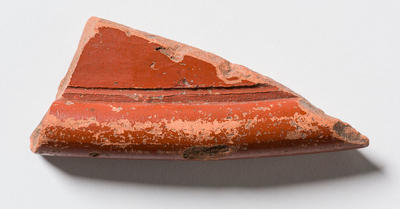Vessel, pottery fragment, rim sherd, Roman terra sigillata
Country
England
See full details
Object detail
Description
Triangular shaped samian ware (Terra Sigillata) pottery fragment with bright glossy orange-red slip over brown fabric. Rim fragment with rounded rim and one coarsely incised band beneath the rim.
Classification
ARCHAEOLOGY Roman
Measurements
L54mm x W22mm x D10mm
Media/Materials description
Pottery vessel made of fired clay, complete or fragmented
Inclusions (quartz) to make the clay less sticky, reduce shrinkage, increase resistance to thermal shock and strength prior to firing.
Gloss (gloss is produced by dipping the vessel into a slip with a high proportion of very fine clay particles. The difference between a slip and a gloss is that a slip is applied to give a different colour, and a gloss is applied to give a sheen to the surface).
Inclusions (quartz) to make the clay less sticky, reduce shrinkage, increase resistance to thermal shock and strength prior to firing.
Gloss (gloss is produced by dipping the vessel into a slip with a high proportion of very fine clay particles. The difference between a slip and a gloss is that a slip is applied to give a different colour, and a gloss is applied to give a sheen to the surface).
History and use
Pottery sherds are broken pieces of pottery, often with irregularly shaped broken edges. How do we know what part of a vessel a sherd came from? Sherds can be classified into one of three categories: rim sherds, body sherds, and base sherds. Rim sherds are the most informative and easy to classify and tell us what kind of rim a vessel had: inslanting, flared or vertical. The curvature of the rim can be measured to tell us the size of the vessels opening. This is a rim fragment.
Terra Sigillata is a type of very fine pottery which was highly desireable in ancient Rome and the Roman empire. Vessels were made in various forms including cups, plates, bowls, platters, mortaria and jars. Some are stamped with the makers or workshop name, which assists in dating and researching trade networks. Some are relatively plainly decorated, wihile others are decorated by pressing the clay into a mould.
These fragments (E40349) are from the sites of Colchester & Veralum. Colchester was the capital of Roman Britain and was a centre for the production of bricks, wine, coins, and pottery. Verulamium is a Roman town in the now Ciy of Albans, and benefited from strong trade routes, connecting Roman towns, settlements and cities at the time.
Terra Sigillata is a type of very fine pottery which was highly desireable in ancient Rome and the Roman empire. Vessels were made in various forms including cups, plates, bowls, platters, mortaria and jars. Some are stamped with the makers or workshop name, which assists in dating and researching trade networks. Some are relatively plainly decorated, wihile others are decorated by pressing the clay into a mould.
These fragments (E40349) are from the sites of Colchester & Veralum. Colchester was the capital of Roman Britain and was a centre for the production of bricks, wine, coins, and pottery. Verulamium is a Roman town in the now Ciy of Albans, and benefited from strong trade routes, connecting Roman towns, settlements and cities at the time.
Registration number
E40349.1



